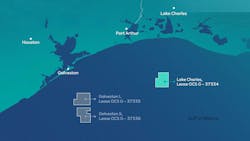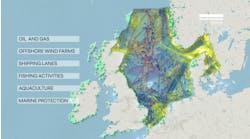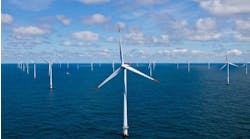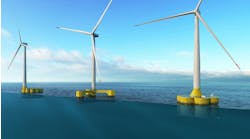Editor's note: This story first appeared in the 2023 Offshore Wind Special Report, which published within the September/October 2023 issue of Offshore magazine.
By Ariana Hurtado, Editor and Director of Special Reports
After much anticipation, the US Bureau of Ocean Energy Management (BOEM) announced on Aug. 29 the results of the US government's first auction of offshore wind development rights in the Gulf of Mexico (GoM). Sole bidder RWE won the rights to more than 102,000 acres 44 miles offshore Louisiana, and there were no bids for the two other lease areas offshore Texas.
Dr. James Kendall, BOEM’s GoM regional director, told Offshore, “[The] lease sale represents a significant milestone for reaching the [US] administration’s goal to deploy 30 gigawatts of offshore wind energy capacity by 2030. The Gulf is well positioned to transition to a renewable energy future, as the region’s existing energy infrastructure, workforce and businesses expertise in offshore operations can immediately advance and benefit offshore wind development. We look forward to holding more offshore wind lease sales in the future.”
RWE Offshore US Gulf LLC was the winner of the Lake Charles lease area for $5.6 million. The awarded site has water depths of 10 m to 25 m. RWE said the project is expected to be in operation by the mid-2030s, contingent upon permitting timelines. The secured GoM lease area is said to have a capacity to develop up to 2 GW of fixed-bottom offshore wind as well as the ability to power more than 350,000 US homes with clean energy. The company’s US offshore wind development portfolio now totals about 5.9 GW capacity, including its New York Bight and California seabed awards in 2022.
“[The] lease sale is a critical step toward further cementing the Gulf’s status as one of the world’s lowest-carbon energy basins,” said Consumer Energy Alliance Vice President Kaitlin Hammons in a news release. “We encourage the Biden administration to embrace both renewable and traditional offshore leasing to meet our energy needs, improve the environment and supply affordable energy for families and businesses.”
Higher project costs
Fifteen companies were qualified to bid during the sale, according to a BOEM document. They included offshore wind development arms of European energy companies Equinor, Shell, RWE and TotalEnergies, all of which are already developing US offshore wind leases in other regions, according to a Reuters report. So, why would companies register if they weren’t planning to bid?
Kris Ohleth, director with Special Initiative on Offshore Wind, told Offshore, "Compared to other regions in US where there have been recent offshore wind lease sales (e.g., New York and California) the bidding was slow and low. This result is not entirely surprising since the Gulf of Mexico states are relatively early in their progress for developing a market for offshore wind, and there are some technical challenges that need to be addressed. Both factors may be keeping developers on the sidelines for now."
Additionally, Samantha Woodworth, Wood Mackenzie’s senior research analyst, North America Wind, told Offshore, “The GoM auction being one of the least competitive lease auctions is not wholly surprising when viewed within the context of the current US offshore wind market as whole. Project costs in the Gulf are likely to be higher than those on the East Coast for a variety of reasons, including the silty seabed making fixed-bottom foundations more difficult to develop, lower wind speeds requiring larger/more efficient turbines to cost-effectively generate energy, additional developmental and cost considerations around hurricane preparedness. And within the context of more commercially ready projects on the East Coast running into cost problems causing contract terminations and renegotiations, developers are just not looking to take on that sort of project cost risk right now.”
She highlighted that another key factor in level of interest between the GoM leases were about the proximity to Texas versus Louisiana coasts.
“The Lake Charles location was, also unsurprisingly, the most coveted area just because it's closest to Louisiana, which has an OFSW [offshore wind] installation target, though any sort of specific OFSW remuneration mechanism (PPAs or ORECs) is as of yet unknown, so that also presents a risk to projects and their necessary returns,” Woodworth said. “The other two are off the coast of Texas, which hasn't expressed much interest in offshore wind so the projects would either pay more to develop transmission from those farther away locations to Louisiana for offtake or go merchant into the Texas market, which has some of the lowest power prices in the country, making project returns difficult. Overall, Gulf OFSW is just not very economic on its own, and especially when considered against onshore wind (in Texas specifically) and solar in the region.”
Woodworth called the Aug. 29 results announcement “a rough day for US offshore wind” but said not to take this as an indicator of the industry’s success in the long term.
“There are several other lease auctions on the horizon that are more likely to garner developer interest such as Oregon and the Gulf of Maine, and the NY and NJ solicitations were both very well subscribed. The appetite is still there, we’re just in a small rough patch,” she added.
Electricity prices
RWE, an energy developer based in Germany, paid $1 billion for its lease in the US East Coast in 2022, and it also snagged a position in California earlier this year for $158 million. So why was there a lack of interest in the GoM region?
“The key standout factor (hurricanes aside) here appears to be electricity prices,” said Phillip Hargreaves, TGS’ new energy solutions ecosystem program director. “Texas ranks 36 out of 50 for electricity costs to end consumers—Louisiana 44th—based on 2021 prices. ... Gross yields are also around 20% lower than some leases in the New York or California Morro Bay area; compounding the problem of lower energy values.”
He continued, “Whilst it will be reported as a reflection of the state of the industry today, tomorrow it is more likely that many developers will see this as a missed opportunity to secure acreage with significantly lower development risks and complexity (shallow, near shore, known subsurface). With today’s dynamic energy prices, increased electrification, and perhaps even demand for hydrogen for export, this may look like a missed bargain for many in the not-too-distant future.”




